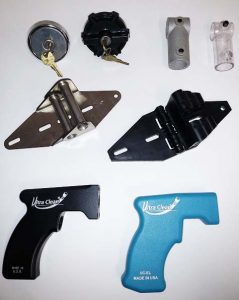Metal-to-Plastic
Converting parts from Metal to Plastic
 We have many customers who have come to us with a desire to reduce the weight, decrease the costs, and/or increase the durability of the current metal parts they utilize.
We have many customers who have come to us with a desire to reduce the weight, decrease the costs, and/or increase the durability of the current metal parts they utilize.
Of course, they often bring their concerns regarding the strength and durability of using plastics.
We have dozens, if not a hundred or more, of examples where we have allowed customers to recoup the many benefits of utilizing the wide variety of properties and characteristics of the plastic resins that are available. There are obvious examples in the parts we produce for suppliers to the automotive industry, but there many more instances where industrial and commercial components have been switched to plastics.
The usual resins used in these instances are either nylon, acetal, or even PC/ABS blends – sometimes reinforced with fiberglass or other mineral additives.
The following is just one case study.
Our customer manufactures outdoor overhead doors that are exposed to significant moisture. The traditional hinge is metal, which is prone to rapid rust and corrosion in this harsh environment. The customer wanted to develop a durable alternative hinge made from plastic to reduce costs and problems associated with corrosion.
Challenges
- Strength and durability were the primary concerns. The plastic hinge had to be strong enough to hinge door panels on large overhead door systems. These hinges also hold guide rollers and receive high levels of stress during the opening and closing of the doors, even when ice builds up in cold weather.
- Interchangeability was the second issue. The plastic hinge had to be interchangeable with pre-existing metal hinges. That way the end-user had the choice of plastic or metal hinges and also had the ability to retrofit existing doors.
Solutions
Guttenberg Industries worked closely with the customer's engineering team to brainstorm multiple design iterations and to prove our designs through prototyping and experimentation. Our engineers recommended top material alternatives and explained the benefits and dangers of each. Our team also developed the assembly process required to install 3-inch rivets used as hinge pins in the assembly.
Outcome
The final product successfully replaced metal hinge assemblies that exceeded the customer's requirements for strength and durability. The plastic hinge is interchangeable and able to be retrofitted with metal hinges already in the field. As a result, the customer can provide rust-free corrosion-proof hinges for the end user.
Contact us today to learn more.
